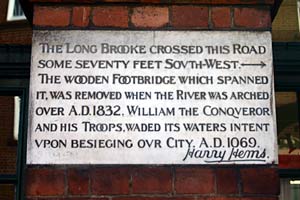
William I besieges Exeter - 1068
Back to historic events in Exeter
If you walk to the bottom of Longbrook Street, you will find on the front of a large red-brick building housing Harry's Restaurant, a plaque that reminds us that William the Conqueror approached the city by crossing the Longbrook and riding up Longbrook Street.
After the Normans won the Battle of Hastings in
1066, Exeter refused to immediately succumb to their rule. In fact, the
Normans had to spread out from south east England, to conquer the land
and it was not until 1068 that they eventually reached the south west.
Saxon Exeter
Exeter had been newly invigorated after the rule of
the Saxon Athelstan
(928AD) and although damaged by the Viking Sweyne in 1003, had quickly
become a well defended, prosperous town that was also the seat of
Leofric, the Bishop of Exeter. In 1066, it is estimated that there were
about 460 houses within the walls, and a population of 2,500. After the
Battle of Hastings, Queen Gytha, the mother of King Harold had taken
refuge in a town house belonging to the Earls of Wessex and the city
was determined to resist the Conqueror.
William returned to Normandy after the Battle of Hastings, but within 18 months, he crossed back to England to deal with rebellion in his new kingdom. He sent emissaries to Exeter to extract a tribute of £18 per year and force the citizens to swear allegiance to him, but to no avail. The citizens of Exeter sent a deputation to William that stated -
"We will not swear fealty to the King, nor admit him within our wall; but will pay him tribute, according to ancient custom".
A personal appearance was needed for this rebellious city!
In the late autumn of 1068, William rode with 500 horsemen westwards
towards Exeter. On the way, he laid waste to the towns of Dorset, as a
warning to Exeter. When four miles from Exeter, the city fathers sent a
delegation to William to negotiate terms, and gave him some hostages,
as a promise that the city would cooperate. When the negotiators
returned to Exeter, the angry citizens repudiated the deal and
preparations were made for a siege.
The siege begins
William, followed by his army, approached the city from the north east by fording the Longbrook and riding up a track that would become Longbrook Street. At East Gate, after the citizens refused to open the gates, he had one of the hostages blinded, to show what to expect. The citizens of Exeter lined the wall and gave obscene gestures to William and his army.
William determined to take the city and prepared for a long siege. His engineers dug tunnels under the East Gate and wall to undermine it. After 18 days, the wall partially collapsed and negotiations were held with the citizens within. William persuaded the defenders to surrender after Bishop Leofric and his clergy carried their holy relics and sacred bible from the Cathedral to William, for him to swear a holy oath that he would not harm the city and its people. With that, he sped off to quell the rebellious Cornish.
Gytha, who had been in residence the whole time, escaped by the Water Gate and down the river by boat. Properties were divided among the conquerors, with William becoming the new owner of 285 houses.
Almost immediately, Baldwin Sheriff of Devon was charged with building a castle at Exeter and 48 houses were demolished to make way for it. The gatehouse of the castle was the first to be built and is the earliest Norman structure in the country, with both Norman arches and Saxon windows and stonework in evidence.
Sources - Two Thousand Years in Exeter by W G Hoskins, Exeter Past by Hazel Harvey, The Story of Exeter by A M Shorto and educational notes held in the West Country Studies Library.
 The plaque by Harry Hems on the front of Harry's Restaurant in Longbrook Street.
The plaque by Harry Hems on the front of Harry's Restaurant in Longbrook Street.  A figure from the King William carpark mural by Elaine Goodwin,
depictin scenes from the Bayeux Tapestry.
A figure from the King William carpark mural by Elaine Goodwin,
depictin scenes from the Bayeux Tapestry.  The Norman Gatehouse of Rougemont Castle was built at William's orders
by Baldwin, Sheriff of Devon.
The Norman Gatehouse of Rougemont Castle was built at William's orders
by Baldwin, Sheriff of Devon.
│ Top of Page │